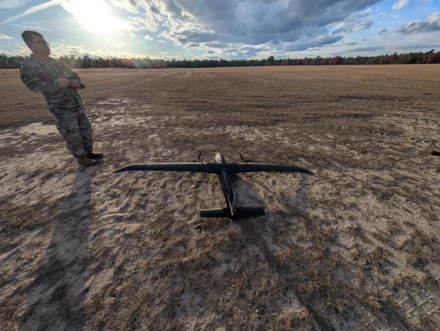JOINT BASE ANDREWS, Md. – A small team of technicians at Joint Base Andrews is helping shape the future of battlefield innovation, one 3D-printed drone at a time.
The Andrews SparkX Cell Innovation and Idea Center partnered with the U.S. Army’s 1st Multi-Domain Task Force from Joint Base Lewis-McChord, Wash., to redesign Project SPECTRE (Small Printable-Engineered-Composites Tailorable Remote-Effect), an experimental effort to create rapidly deployable, customizable, small, unmanned aircraft systems.
The result of Project SPECTE was Blackbird, a fully open-source, government-owned drone platform that cut development costs by more than $1 million.
According to SparkX technicians, the Blackbird can be 3D-printed and assembled in 36 hours for about $200, offering a low-cost, modular sUAS solution for training and operational use in the field.
“Working within the government always provides an opportunity for quicker development that often times faces less roadblocks and is more cost-effective than the standard acquisition processes,” said a Soldier with the 1st MDTF.
With no formal aerospace engineering training, the SparkX technicians reverse-engineered a new platform from scratch. They developed an original airframe that met operational goals while avoiding intellectual property conflicts with the Army’s previous partner.
“It was what we envisioned the plane to look like,” recalled Staff Sgt. Stefan N. Sobiech, a former SparkX technician who is now stationed at Osan Air Base, Republic of Korea. “I oversaw creation of the wings, and I sought inspiration from the most efficient planes I could find.”
The project went through more than 10 variations, but Sobiech said the team kept pressing and learning from their mistakes.
“I don’t think there was ever an obstacle that we didn’t think we could work no past it,” he said. “We always went back at it from a different angle or researched how others got past a similar issue.”
The final design includes two propeller-driven motors, a wingspan of more than six feet and weighed approximately nine pounds. Its modular design features a push-to-connect fuselage and a customizable internal equipment tray, allowing for rapid swaps of mission-specific gear and easy to assembly in the field with no specialized tools.
In November, the team was invited to fly the drone during Titan Hoplite, a joint exercise hosted by the Air Force’s Task Force 99 at Shaw Air Force Base, S.C. The SparkX technicians showcased their airframe alongside other advanced sUAS technologies, drawing interest from units across the Department of Defense.
Sobiech said the team conducted a 30-second shakedown flight before heading to Shaw, where the Blackbird flew for more than two minutes during Titan Hoplite demonstration.
The drone unfortunately crashed after flying out of range of the hobby-grade motors and avionics.
Although, Sobiech was unable to attend the event, he mentioned receiving texts and video footage from observers of the successful flight.
“I was ecstatic! To see it sustaining flight, for that length of time, was an amazing feeling,” he said.
Earl Bagwell, Spark X director, said the Titan Hoplite demonstration sparked interest from several organizations in the Army and Air Force that wanted to get involved.
Bagwell released the 3D files as an open source to allow other units to 3D-print the components and integrate their own avionics and motors.
“We knew this would be a sought-after capability, but instead of going through the long patent process, we decided to open source it,” Bagwell said. “Whoever needs it can have it—because we need to innovate and move faster.”
The Air Force Research Laboratory, the Army Research Laboratory, Combat Innovation Lab, Tesseract, and 2nd MDTF are among the organizations that have accessed to the Blackbird files. Together, they support operational theaters across U.S. Indo-Pacific Command, Central Command, Europe, Africa, special operations, and the Army National Guard.
The 1st MDTF successfully deployed and tested the system in various environments, implementing rapid design updates on-site to improve both their understanding of the platform and its capabilities.
“Working in the joint force allows us to consider multiple angles and employment methods that might not be considered in an Army-only environment,” said an 1st MDTF Soldier. “It also gives us access to resources and diverse skill sets not inherent within individual services.”
Story by Patrick Griffith, 316th Wing




